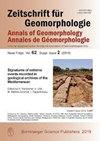Rockfall runout modelling for hazard zonation considering macro-topographic dispersion
IF 1.3
3区 地球科学
Q3 GEOGRAPHY, PHYSICAL
引用次数: 0
Abstract
To avoid damage on infrastructure and loss of life, rockfall hazard zonation based on numerical simulation, has become an important tool for land use planning. Due to process-complexity and scale-dependency of input data, rockfall runout modelling is still subject to many uncertainties. Based on the specific geologic conditions (e.g. lithology, fabric, discontinuities, tectonics), detached block sizes at the cliff face vary significantly. Furthermore, released rock masses tend to disintegrate into fragments after the first impact. Depending on size and shape of the detached block and boulder/surface interaction, modelling trajectories of these fragments is a difficult task. A few sophisticated simulation tools are able to consider rebound-effects as well as macro-, and micro-topographic factors controlling lateral dispersion. However, these models require a set of high-precision terrain and vegetation roughness parameters – which are typically not available for large areas. We propose an alternative grid-based approach applicable for runout modelling at regional scale, since today high resolution digital terrain models are available for large areas. Thus, we suggest modelling rockfall propagation by considering macro-topographic lateral dispersion and different boulder sizes even at regional scale. For this purpose we used varying coefficients of friction for different boulder sizes and a rockfall model introducing a stochastic multiple flow algorithm to consider lateral dispersion. The results are evaluated by comparing model results with rockfall deposits derived from field mapping and analysis of orthophotos. Furthermore, the method’s reliability is analyzed in terms of iteration-dependency of the stochastic function. The approach and the model setup have been investigated in a small alpine study area. The results demonstrate that the presented method can contribute to rockfall runout modelling with sufficient accuracy for the generation of indicative hazard maps at regional scale.考虑宏观地形分散的危险区划岩崩跳动模型
为了避免对基础设施的破坏和生命的损失,基于数值模拟的岩崩危险区区划已成为土地利用规划的重要工具。由于输入数据的过程复杂性和尺度依赖性,岩崩跳动建模仍然存在许多不确定性。根据具体的地质条件(如岩性、构造、不连续面、构造),悬崖表面的分离块体大小差异很大。此外,释放出来的岩体在第一次撞击后往往会分解成碎片。根据分离块体和巨石/表面相互作用的大小和形状,建模这些碎片的轨迹是一项艰巨的任务。一些复杂的模拟工具能够考虑回弹效应以及控制横向分散的宏观和微观地形因素。然而,这些模型需要一组高精度的地形和植被粗糙度参数,而这些参数通常不适用于大面积。我们提出了另一种基于网格的方法,适用于区域尺度的跳动建模,因为今天高分辨率的数字地形模型可用于大面积。因此,我们建议通过考虑宏观地形横向分散和区域尺度上不同的巨石大小来模拟岩崩传播。为此,我们对不同大小的岩石使用了不同的摩擦系数,并建立了一个引入随机多重流算法来考虑横向分散的岩崩模型。通过将模型结果与现场测绘和正射影像分析得出的岩崩沉积物进行比较,对结果进行了评价。此外,从随机函数的迭代依赖性角度分析了该方法的可靠性。在一个小的高寒研究区对该方法和模型建立进行了研究。结果表明,所提出的方法可以为岩崩跳动建模提供足够的精度,用于生成区域尺度的指示性灾害图。
本文章由计算机程序翻译,如有差异,请以英文原文为准。
求助全文
约1分钟内获得全文
求助全文
来源期刊

Zeitschrift fur Geomorphologie
地学-地球科学综合
CiteScore
2.00
自引率
4.50%
发文量
14
审稿时长
6-12 weeks
期刊介绍:
Zeitschrift für Geomorphologie main volume is a peer-reviewed international journal presenting original contributions of high scientific standard from all fields of geomorphology, encompassing basic research and applied studies. Zeitschrift für Geomorphologie (ZfG) invites the submission of original papers from the entire field of geomorphological research, both applied and theoretical. Authors are encouraged to submit their papers to the editor-in-chief. Please peruse the instructions to authors (PDF) before submitting your paper.
 求助内容:
求助内容: 应助结果提醒方式:
应助结果提醒方式:


